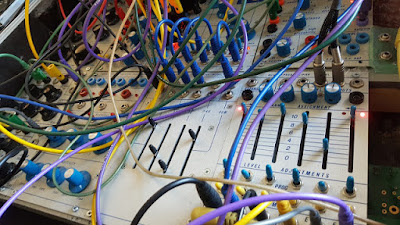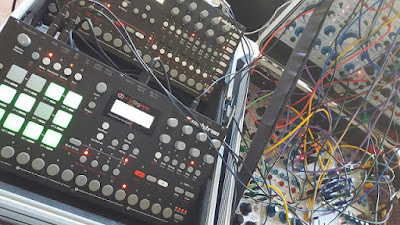I just returned from a Synthesizer Convention in Tokyo.
I had a blast and have caught the bug.
Here is a list of Synth conventions around the world.
If I have left any out do let me know.
------------------------------------------------------------
Jan
The National Association of Music Merchants Show
Official Website: https://www.namm.org/
Jan 16-19, 2020
----------------------------------------------------------
Feb
-----------------------------------------------------
March
Synthplex
https://www.synthplex.com/
Around March 26/29
Burbank CA, USA.
------------------------------------------------------------
April
Musikmesse
Official Website: https://musik.messefrankfurt.com/frankfurt/en.html
Location: Messe Frankfurt - Forum, Frankfurt, Germany
Moogfest
Official Website: https://www.moogfest.com/
16 April - 19th April, 2020
Durham, NC, USA
Ableton Loop event
https://loop.ableton.com/2018/live/
https://www.ableton.com/en/blog/loop/
https://loop.ableton.com/2020/
Berlin April 24-26 2020
Superbooth
Official Website: https://www.superbooth.com/en/landing.html
https://www.superbooth.com/en/
Thu, 23 Apr 2020 – Sat, 25 Apr 2020
Location: FEZ-Berlin, Berlin, Germany
---------------------------------
May
Synthfest France (https://www.synthfestfrance.com/
Nantes, France
22/23/24 May 2020
-------------------------------------------
June
July
----------------------
August
Modular Day, Barcelona
https://www.facebook.com/ModulardayBCN/
30/31 August 2019
KISS2019 - Kyma International Sound Symposium
https://kiss2019.symbolicsound.com/
August/Sept 29/1
-----------------------------------------------------------
Sept
Knobcon
Official Website: https://www.knobcon.com/
Sept 6/8, 2019
Chicago
Dutch Modular Fest
https://www.dutchmodularfest.com/
Sept 27.28, 2019
New England Synthesizer Festival
https://www.facebook.com/events/2324604164460137
Sept 28, 2019
-----------------------------------------------------
October
Synth Fest UK
https://www.synthfest.co.uk/
Sheffield
Oct 5, 2019
Zurich Modular
http://zurichmodular.ch/
Oct, 18-19, 2019
-------------------------------------------------------
November
Tokyo Festival of Modular
http://tfom.info/
16/17 Nov, 2019
Dallas Synth Meet
https://www.facebook.com/DFWSynths/
Nov, 10, 2019
Soundmit
Turin, Italy
https://www.soundmit.com/en
02/03 Nov, 2019
------------------------------------------------
December
I had a blast and have caught the bug.
Here is a list of Synth conventions around the world.
If I have left any out do let me know.
------------------------------------------------------------
Jan
The National Association of Music Merchants Show
Official Website: https://www.namm.org/
Jan 16-19, 2020
----------------------------------------------------------
Feb
-----------------------------------------------------
March
Synthplex
https://www.synthplex.com/
Around March 26/29
Burbank CA, USA.
------------------------------------------------------------
April
Musikmesse
Official Website: https://musik.messefrankfurt.com/frankfurt/en.html
Dates: Wed, 1 Apr 2020 – Sat, 4 Apr 2020
Moogfest
Official Website: https://www.moogfest.com/
16 April - 19th April, 2020
Durham, NC, USA
Ableton Loop event
https://loop.ableton.com/2018/live/
https://www.ableton.com/en/blog/loop/
https://loop.ableton.com/2020/
Berlin April 24-26 2020
Superbooth
Official Website: https://www.superbooth.com/en/landing.html
https://www.superbooth.com/en/
Thu, 23 Apr 2020 – Sat, 25 Apr 2020
Location: FEZ-Berlin, Berlin, Germany
---------------------------------
May
Synthfest France (https://www.synthfestfrance.com/
Nantes, France
22/23/24 May 2020
-------------------------------------------
June
July
----------------------
August
Modular Day, Barcelona
https://www.facebook.com/ModulardayBCN/
30/31 August 2019
KISS2019 - Kyma International Sound Symposium
https://kiss2019.symbolicsound.com/
August/Sept 29/1
-----------------------------------------------------------
Sept
Knobcon
Official Website: https://www.knobcon.com/
Sept 6/8, 2019
Chicago
Dutch Modular Fest
https://www.dutchmodularfest.com/
Sept 27.28, 2019
New England Synthesizer Festival
https://www.facebook.com/events/2324604164460137
Sept 28, 2019
-----------------------------------------------------
October
Synth Fest UK
https://www.synthfest.co.uk/
Sheffield
Oct 5, 2019
Zurich Modular
http://zurichmodular.ch/
Oct, 18-19, 2019
-------------------------------------------------------
November
Tokyo Festival of Modular
http://tfom.info/
16/17 Nov, 2019
Dallas Synth Meet
https://www.facebook.com/DFWSynths/
Nov, 10, 2019
Soundmit
Turin, Italy
https://www.soundmit.com/en
02/03 Nov, 2019
------------------------------------------------
December











































































































































 ....
.... ///
///





























